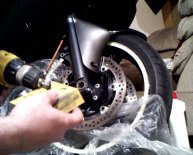
Paint Motorcycle Frame
During a motorcycle restoration, the property owner will undoubtedly be faced with many challenges. One of these difficulties will concern the area finish of a product, or even be more accurate: whether to possess a product painted, plated or powder coated. The decision will typically fall towards the cost or perhaps the likely dependability associated with the component. For instance, an owner might opt to have a-frame dust coated instead of artwork.
However, if price is a major consideration, owners should decorate the frame by themselves.
On a few of the older bicycles the property owner will discover lots of installation brackets. Brackets to mount batteries, horns, seats, etc. are typical and, during a restoration, the full total costs is held straight down because of the owner painting small items him or by herself.
Every one of the major automobile stores carry a large variety of spray paints available in pressurized cans. The sort of paints offered at these kinds of outlets is significantly limited, but appropriate for tiny parts eg brackets.
Planning is the Key
It's been stated often by professional painters that planning is the key to a finish, but it is well worth repeating here, once the quantity of work essential to apply the final paint finish is negligible when compared to planning required. Much like many focus on classic bikes, cleaning may be the very first part of the work (once a product was taken from the bike). But the less experienced mechanic is well advised to photograph any disassembly required—especially if a shop manual is certainly not available.
All of the time during planning stage of spraying a component, the auto mechanic should put on latex gloves. Besides safeguarding the mechanic’s fingers, exudate gloves also protect the component from all-natural greases and essential oils found real human epidermis that will cause problems whenever applying the paints.
Degreasing
Cleaning of element should firstly be performed in a degreasing container (if offered) followed by drying out with an air line before spraying (or wiping using a report towel) with a substance eg break cleaner, which will perhaps not keep an oily residue.
Elements having old paint or rust on it should always be grit blasted now if an appropriate machine is present; instead, the auto mechanic must wire clean the things and, or, sand them with wet/dry report. If the element features bearings or other things that should be safeguarded through the grit, it will be important to entirely seal the location with aluminum foil tape. Particular components should be blasted with cooking soda which can be less intense and may be washed off with water. After blasting, the component should once more be washed and degreased.
At this stage the auto mechanic could find something needs to have a tiny indentation filled with Bondo™, but before you apply the filler product the location should really be dispersed with a primer eg an etching primer. But some restorers choose to have the components powder coated during this period to fully secure all of them before applying any filler product. Items particularly steel fenders get into this group.
After adding fillers and sanding the location level, the auto mechanic must re color the location with etching primer once again. Prior to the top coating of paint could be applied, the element might need to be sanded with a really fine wet/dry report particularly a 1200 quality grit paper. (Note: The mechanic must work out great caution when sanding at this point so as not to expose any bare metal.)
The last period of painting an element is to apply the very best coating. But is vital to follow some standard principles of squirt artwork incase the auto mechanic isn't experienced with spray painting (even from an aerosol can) he should exercise on some scrap product of the same composition due to the fact element he intends to color.
Fundamental Spray Painting Procedures
Most shows used on motorbikes have actually harmful elements that may be dangerous towards respiratory system. For that reason, masks created for squirt painting must be used. In addition, as previously mentioned within the text, latex gloves must certanly be used constantly during the artwork treatment.
Spray paint will adhere to the element as directed because of the painter; but a specific amount will miss it and land on nearby objects. The nearer these objects are into the spray because it will leave the squirt nozzle will additionally be coated, products further away will gain a dust like appearance which may be very hard to wash off—typically requiring solvents to complete.
All components should be dispersed with a primer initially before any finishing layer. Etching primers would be best for any metallic components.
The surroundings conditions which a component is dispersed could have a substantial impact on the last finish. Ideally, the location must be dust free, heated to the paint maker’s tips therefore the moisture should really be fairly reduced.
Although a recently dispersed product may be touch-dry, the mechanic must withstand the urge to manage it until it really is completely dry—even the pressure needed to raise something can penetrate brand-new paint and leave a little finger printing.

















